Produced and Directed by Joe Barbera and Bill Hanna.
Credits: Animation – Art Davis, Layout – Paul Sommer, Backgrounds – Art Lozzi, Written by Warren Foster, Story Director – Alex Lovy, Titles – Art Goble, Production Supervision – Howard Hanson.
Voice Cast: Huckleberry Hound, Gate Attendant 1, Spy with Clock, Spies – Daws Butler; Narrator, Chief, P.A. Announcer, Gate Attendant 2, Clock-Stealing Spy, Spy with Gun, Conductor, Spies – Don Messick.
Music: Hoyt Curtin.
Episode: Huckleberry Hound Show K-052.
First Aired: week of March 27, 1961.
Plot: Agent Huckleberry Hound is assigned to deliver a secret-filled briefcase to the country of Rutabaga.
This spy spoof is really inspired. There are a lot of fun lines and lampooned situations from start to finish, too many to quote. Huckleberry Hound seems to have brought out the best in Warren Foster, perhaps because Huck could be plunked in a different situation in each cartoon, enabling Foster to make fun of something fresh.
Interestingly, there are no Russian or eastern European accents in this cartoon, despite being loaded with spies and set in the Cold War days of 1961. Daws Butler and Don Messick pretty much keep to French accents, as the second half of the cartoon is set on a train from Paris to Rutabaga called the Rutabaga Express, a parody of the Orient Express on which a number of spy novels and films have been based. Well, it may be going to Rutabaga.
The cartoon opens with a great back-and-forth between Huck and the narrator. Huck is an agent with the T.S. and S.L.T.T.—“Top Secrets and Stuff Like That There.” First, Huck looks around when the narrator firsts talks to him because he can’t see him. Then Agent Hound sets up a gag. “Sorry, Mr. Narrator,” he apologises, but information about his agency is classified. So is his next mission. And so is the book he’s carrying—the Classified Phone Directory. “Ain’t that a knee-slapper?” asks Huck. “I get it,” dourly replies the narrator, who finally gets angry when his joke to Huck goes over the spy’s head.
Image may be NSFW.
Clik here to view. Image may be NSFW.
Image may be NSFW.
Clik here to view. Image may be NSFW.
Image may be NSFW.
Clik here to view.
Huck’s called “The Man With a Thousand Faces.” It turns out it’s not because Huck is a master of disguise. He demonstrates a face.
Image may be NSFW.
Clik here to view.
Fade to Huck in the chief’s office (with a stylised painting of George Washington by Art Lozzi). Huck’s being assigned to deliver a briefcase to the Ambassador in Rutabaga. “Where is Rutabaga?” Huck asks. “That’s a good question,” says the chief, who now stops to think. “Rutabaga, rutabaga, let me see. I should know that. But these countries keep changing their names.” The chief was right. The cartoon was made during a period when French African colonies were becoming independent. The incompetent Huck tries to leave the office but walks into a broom closet, losing the briefcase in the process. “I’m off to Battaruga,” says Huck. “That’s Rutabaga, Rutabaga! Not Battaruga,” shouts the chief, who then ponders “Or is it? They could have changed the name again.”
After someone tries to drop an anvil on Huck and then switch his briefcase with a lunch box, Huck is on a flight to Paris. He explains that sometimes, a lady spy will be planted in the next airplane seat to try to get him to talk. No sooner does Huck tell us a smart agent doesn’t do that, he blabs virtually everything (except he calls the country “Turnip”) and even invites the turbaned lady to peek in the briefcase before he realises what he’s said.
The lady doesn’t figure into the plot; she’s just a gag device. Now we get spies galore on the Spy Special. Some have identical white trench coats and blue sunglasses. Huck’s briefcase gets stolen and everyone’s after it. They chase each other back and forth from left to right of the frame, laughing and screeching like crazy (though their mouths don’t move). Finally, Huck asks the conductor for help to get his briefcase back. It’s not forthcoming. The conductor explains: “This is the Spy Express. Everybody steals each other’s bag. That’s how the spies keep their job. So, take a bag, Monsieur. Any bag. They all have secrets in them.” So that’s just what he does when a blob of spies passes by him.
Image may be NSFW.
Clik here to view. Image may be NSFW.
Image may be NSFW.
Clik here to view.
The scene fades into the climax—the lumped group of spies chase Huck on top of the rail cars. A tunnel’s approaching. You can guess what happens. Huck’s smart enough to duck. The others aren’t. We don’t actually see them hit the top of the tunnel. Instead, the scene cuts from the group pointing ahead to stock animation of the impact of an explosion you’ve seen in countless H-B cartoons.
Image may be NSFW.
Clik here to view.![]() Image may be NSFW.
Image may be NSFW.
Clik here to view.![]() Image may be NSFW.
Image may be NSFW.
Clik here to view.![]()
The final scene is back in the chief’s office in the Capitol in Washington, D.C. Huck has captured all the briefcases the spies had. “Only the Man of a Thousand Faces could have pulled this off,” says the chief, admiringly. “I know,” replies the immodest Huck, who once again demonstrates the silly face he made to the Narrator earlier in the cartoon. Then he confides in us it’s the only face he can do, “it’s just lucky for me nobody ever asks to do another one.” Huck launches into an a cappella version of “Clementine” to end the cartoon (with the goony face tossed in for good measure). Art Lozzi put George Washington on the office wall. It looks like his other portrait belongs to President Dracula. Maybe that’s a sly comment by someone on the U.S. government sucking tax dollars.
Speaking of Lozzi, here’s his streetscape, from start to finish.
Image may be NSFW.
Clik here to view.![]()
This was the last new Huckleberry Hound cartoon aired in the 1960-61 season. Unlike the others, it uses underscore music written by Hoyt Curtin, as would the nine Huck cartoons produced in the following, and last, season.
Credits: Animation – Art Davis, Layout – Paul Sommer, Backgrounds – Art Lozzi, Written by Warren Foster, Story Director – Alex Lovy, Titles – Art Goble, Production Supervision – Howard Hanson.
Voice Cast: Huckleberry Hound, Gate Attendant 1, Spy with Clock, Spies – Daws Butler; Narrator, Chief, P.A. Announcer, Gate Attendant 2, Clock-Stealing Spy, Spy with Gun, Conductor, Spies – Don Messick.
Music: Hoyt Curtin.
Episode: Huckleberry Hound Show K-052.
First Aired: week of March 27, 1961.
Plot: Agent Huckleberry Hound is assigned to deliver a secret-filled briefcase to the country of Rutabaga.
This spy spoof is really inspired. There are a lot of fun lines and lampooned situations from start to finish, too many to quote. Huckleberry Hound seems to have brought out the best in Warren Foster, perhaps because Huck could be plunked in a different situation in each cartoon, enabling Foster to make fun of something fresh.
Interestingly, there are no Russian or eastern European accents in this cartoon, despite being loaded with spies and set in the Cold War days of 1961. Daws Butler and Don Messick pretty much keep to French accents, as the second half of the cartoon is set on a train from Paris to Rutabaga called the Rutabaga Express, a parody of the Orient Express on which a number of spy novels and films have been based. Well, it may be going to Rutabaga.
The cartoon opens with a great back-and-forth between Huck and the narrator. Huck is an agent with the T.S. and S.L.T.T.—“Top Secrets and Stuff Like That There.” First, Huck looks around when the narrator firsts talks to him because he can’t see him. Then Agent Hound sets up a gag. “Sorry, Mr. Narrator,” he apologises, but information about his agency is classified. So is his next mission. And so is the book he’s carrying—the Classified Phone Directory. “Ain’t that a knee-slapper?” asks Huck. “I get it,” dourly replies the narrator, who finally gets angry when his joke to Huck goes over the spy’s head.
Image may be NSFW.
Clik here to view.
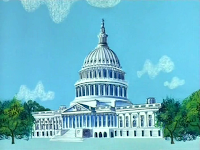 Image may be NSFW.
Image may be NSFW.Clik here to view.
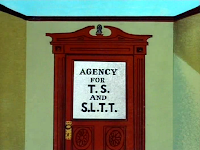 Image may be NSFW.
Image may be NSFW.Clik here to view.
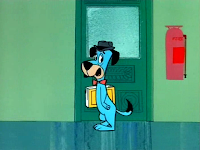
Huck’s called “The Man With a Thousand Faces.” It turns out it’s not because Huck is a master of disguise. He demonstrates a face.
Image may be NSFW.
Clik here to view.

Fade to Huck in the chief’s office (with a stylised painting of George Washington by Art Lozzi). Huck’s being assigned to deliver a briefcase to the Ambassador in Rutabaga. “Where is Rutabaga?” Huck asks. “That’s a good question,” says the chief, who now stops to think. “Rutabaga, rutabaga, let me see. I should know that. But these countries keep changing their names.” The chief was right. The cartoon was made during a period when French African colonies were becoming independent. The incompetent Huck tries to leave the office but walks into a broom closet, losing the briefcase in the process. “I’m off to Battaruga,” says Huck. “That’s Rutabaga, Rutabaga! Not Battaruga,” shouts the chief, who then ponders “Or is it? They could have changed the name again.”
After someone tries to drop an anvil on Huck and then switch his briefcase with a lunch box, Huck is on a flight to Paris. He explains that sometimes, a lady spy will be planted in the next airplane seat to try to get him to talk. No sooner does Huck tell us a smart agent doesn’t do that, he blabs virtually everything (except he calls the country “Turnip”) and even invites the turbaned lady to peek in the briefcase before he realises what he’s said.
The lady doesn’t figure into the plot; she’s just a gag device. Now we get spies galore on the Spy Special. Some have identical white trench coats and blue sunglasses. Huck’s briefcase gets stolen and everyone’s after it. They chase each other back and forth from left to right of the frame, laughing and screeching like crazy (though their mouths don’t move). Finally, Huck asks the conductor for help to get his briefcase back. It’s not forthcoming. The conductor explains: “This is the Spy Express. Everybody steals each other’s bag. That’s how the spies keep their job. So, take a bag, Monsieur. Any bag. They all have secrets in them.” So that’s just what he does when a blob of spies passes by him.
Image may be NSFW.
Clik here to view.
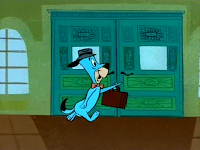 Image may be NSFW.
Image may be NSFW.Clik here to view.
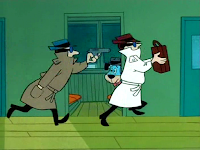
The scene fades into the climax—the lumped group of spies chase Huck on top of the rail cars. A tunnel’s approaching. You can guess what happens. Huck’s smart enough to duck. The others aren’t. We don’t actually see them hit the top of the tunnel. Instead, the scene cuts from the group pointing ahead to stock animation of the impact of an explosion you’ve seen in countless H-B cartoons.
Image may be NSFW.
Clik here to view.
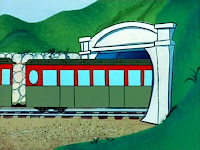 Image may be NSFW.
Image may be NSFW.Clik here to view.
 Image may be NSFW.
Image may be NSFW.Clik here to view.
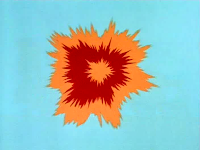
The final scene is back in the chief’s office in the Capitol in Washington, D.C. Huck has captured all the briefcases the spies had. “Only the Man of a Thousand Faces could have pulled this off,” says the chief, admiringly. “I know,” replies the immodest Huck, who once again demonstrates the silly face he made to the Narrator earlier in the cartoon. Then he confides in us it’s the only face he can do, “it’s just lucky for me nobody ever asks to do another one.” Huck launches into an a cappella version of “Clementine” to end the cartoon (with the goony face tossed in for good measure). Art Lozzi put George Washington on the office wall. It looks like his other portrait belongs to President Dracula. Maybe that’s a sly comment by someone on the U.S. government sucking tax dollars.
Speaking of Lozzi, here’s his streetscape, from start to finish.
Image may be NSFW.
Clik here to view.

This was the last new Huckleberry Hound cartoon aired in the 1960-61 season. Unlike the others, it uses underscore music written by Hoyt Curtin, as would the nine Huck cartoons produced in the following, and last, season.




